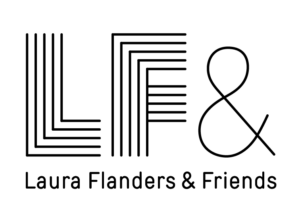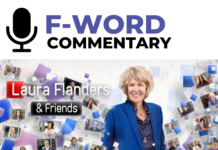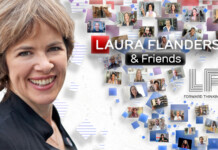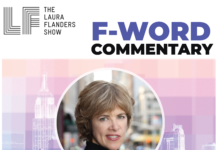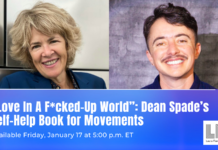Crip Camp is a Peabody Award-winning documentary from Netflix and Higher Ground Productions that tells the story of Camp Jened, a summer camp in the 1960s where disabled youth could be themselves. The film follows several former campers who went on to be leaders of the Disability Rights Movement. Laura speaks with the directors and producers of Crip Camp about how they are using the film to advance the next step in the revolution: Disability Justice, a movement that centers the leadership of disabled queer, trans, Black, Indigenous, and people of color. If the inclusive culture of Camp Jened could help transform American society in the second half of the 20th century, what could a truly intersectional Disability Justice Movement change for us all today? Plus thoughts from Laura on interdependence.
Guests
- Andraéa LaVant, Impact Producer & President, Chief Inclusion Officer of LaVant Consulting Inc.
- Jim LeBrecht, Co-Director Crip Camp: A Disability Revolution, Peabody Winner & Oscar Nominated Film
- Nicole Newnham, Co-Director Crip Camp: A Disability Revolution, Peabody Winner & Oscar Nominated Film
To listen to the uncut interviews, and to get episode notes for this episode and more, become a Patreon partner here.
Prefer to Listen?
Transcript
THE LAURA FLANDERS SHOW
DID A SUMMER CAMP HELP SPARK A DISABILITY REVOLUTION?
LAURA FLANDERS: What can a small pocket of inclusive culture make possible for people who are normally marginalized or excluded from mainstream society? Crip Camp: A Disability Revolution is a Peabody award-winning documentary from Netflix and Higher Ground Productions that tells the story of Camp Jened, a summer camp in Upstate New York in the 1960s where disabled young people could be themselves. The film follows former campers into their adulthoods as activists whose work during the ’70s and ’80s helped secure federal civil rights for disabled people and eventually led to the passage of the Americans with Disabilities Act in 1990. But the story doesn’t end there, the disability rights movement, like so many movements in American history, prioritized at first the leadership visibility and needs mostly of white straight cis-gender disabled people. Recognizing this, the directors and producers of Crip Camp are using their film’s release to educate audiences about the next step in the revolution, disability justice. That movement centers the leadership of disabled queer, trans, Black, Indigenous and people of color. If the inclusive culture of Camp Jened could help transform American society in the second half of the 20th century they ask, what could a truly intersectional disability justice movement change for everyone today?
Joining me are co-producers and co-directors of Crip Camp: A Disability Revolution, Jim LeBrecht and Nicole Newnham. And Andraéa LaVant, she’s chief inclusion officer of LaVant Consulting, Inc. I’d like to begin first with congratulating you all for the Peabody award, which was announced this June. Incredibly well-deserved, congratulations all of you. And then, I mean, coming to you, Jim, you and so many people in the film, Crip Camp: A Disability Revolution, talk about what kind of experience you had at the camp itself and how it changed you.
JIM LEBRECHT: Well, the camp changed me because for the first time really I saw things modeled for me that I hadn’t really seen, like adults with disabilities having jobs, having responsibilities, and also the way that we all treated each other. I was a 15 year old guy. I was an idiot as much as any other 15 year old teenager. Right? But there, I’m in an environment that was not typical for me. I wasn’t around a lot of people who had disabilities, but there I looked to the people around me and learned about patience. If somebody, it took them a long time to say something or just accepting people for who they are. I think that the question also that you’re asking is what about today, right? What are the lessons that I learned at Camp Jened? Well, well before there was disability justice, I was already learning about caring about each other. And this is one of the most important lessons I’ve learned as I’ve been educated by disability justice. And you see this also displayed in the film and the 504 Sit-in. That you take people at face value. You ask people what they need. You respect that. You don’t question that. But I think one of the first rules is caring for yourself and caring for the wellbeing of the people around you.
LAURA FLANDERS: Nicole, coming to you for a second, you’ve done documentaries about a variety of things. How did you hook up with Jim here?
NICOLE NEWNHAM: Well, disability, I mean, like everybody one in four of us are disabled. And so everyone has disability in their life in some way or another, or crosses disability over the course of their life. So it was a big part of my life, but I first learned about disability as kind of a community and a culture and as a political movement through Jim, because Jim was my sound designer and mixer for 15 years on three previous feature length documentaries. And over the years, we had increasingly kind of intense and interesting conversations about the lack of access and the discrimination that people with disabilities faced in our own industry in the documentary film world. And I was fascinated by it and realized that I was not really aware and didn’t really have my eyes opened to a lot of the injustices around us. I thought about lots of different other kinds of civil rights issues, but I didn’t see disability as a civil rights issue. And so Jim said, “I think that you might be interested in directing some ideas about disability, documentaries about disability related themes. And would you go out to lunch and hear some of my ideas?” And he pitched me a few interesting ideas, but it was at the end, something in the emotion of his voice when he said, “Well, what I’ve really always wanted to see was a film about my summer camp.” Made me ask why. And he started telling me about not only the camp, but his theory that the revolutionary experience of the camp and the freedom that people found there was connected to the disability rights movement that came later. And we decided to partner on it. I said, “I don’t really think this is my story to direct. I think we should co-direct it so it’s disability-led and told primarily from your point of view and through your voice,” and it’s been an incredible, incredible journey.
LAURA FLANDERS: Andraéa, talk about what drew you to the project? It’s an obvious question, but you have many aspects to the job that you’re doing there, and I’d love you to talk about how you saw this opportunity, how you grasped it and how it’s working out, what kind of reception the film’s getting.
ANDRAÉA LAVANT: There was a history that I knew about that most people didn’t know about. And I didn’t even know about Camp Jened, but just even knowing about the 504 Sit-ins and Ed Roberts and the Centers for Independent Living and all of those things that I wasn’t aware of until I really started in this work. And so I was excited about just others, being in a mainstream space, those types of conversations. I had no idea until having an opportunity to view the film early on that it would be as powerful as it was and have so many messages to share. And so for me, as a Black woman I still, I know personally never quite felt like I fit in even in disability spaces. And so what I saw was an opportunity to acknowledge what was and what was shared, and then also to elevate and bring more people to the forefront that represent the intersectional identities of disabled folks.
LAURA FLANDERS: So if people have been listening carefully to this conversation so far, they will have heard the terms disability rights and disability justice used. They’re not exactly the same, and Crip Camp shows, in a sense, the transition from one to the other. The film follows campers into their adulthood. Many of whom became activists like Jim and Judy Heumann and a bunch of others whose work in the ’70s and ’80s helps win America’s most recent civil rights victory, really, in the ADA, the Americans with Disabilities Act that was signed in 1990 by George Bush, Sr., but the story doesn’t end there. And the disability rights movement, which had at its center white, straight, mostly cis guys and notions of independence and autonomy has been changed in the current era into one that puts people of color, queer people and interdependence at the center, as well as a kind of critique of society as it is for all of us. Jim, talk if you will, about how you see the distinction and what has had to change or has changed in your own thinking about these issues doing this work.
JIM LEBRECHT: As your kind of typical liberal white guy, I thought I really kind of knew a lot. And as we were working on the film, first off, it was very important to Nicole and I that we acknowledged the fact that the contributions of people of color, LGBTQ, had not been shown very much at all, and that we do our best to really highlight the contributions of people from those communities. I just think that by getting to know Andraéa and our impacting campaign and the readings that I wound up doing, I became a lot smarter about this. One of the lessons I think I’ve learned is that ignorance is dangerous. I think it’s up to all of us to really kind of understand each other.
LAURA FLANDERS: Is independence your goal, Andraéa?
ANDRAÉA LAVANT: No, interdependence is really my goal. It’s acknowledging that we’re really better together and it’s not tied to a specific diagnosis or a specific type of body, disabled or non-disabled. But it’s really acknowledging that we have an opportunity to support one another in such a way that we’re able to live the lives that we deserve to live, that we want to live. And so it’s not separate from, but it’s with.
LAURA FLANDERS: I just want to underscore for people, I grew up a child of a person with a disability, a guy in a wheelchair who worked in theater. I watched what his life was like, and the discussion was about independence and autonomy, but that was not how he could ever have thrived, not how any of us actually thrive. Everything that he was able to do, Michael Flanders, was partly thanks to my mom and thanks to lots of other people. And I think that’s how we all live. And if we had not been aware of that, this COVID year certainly reminded us of that. So with this outreach campaign that you have launched around Crip Camp: A Disability Revolution, what are your goals? What are your metrics for success? What are you actually doing with, for example, the Peabody? Nicole, you want to weigh in on this?
NICOLE NEWNHAM: I think one of the great things about bringing Andraéa and Stacey Park Milbern, the two incredible activists who kind of held the original vision for the campaign and what the film could do in the world, was that they saw an opportunity to use the spotlight on the film, of which the Oscar nomination and the Peabody are things that draw people to the film, as kind of an on-ramp to being able to access wisdom and teachings of people in the disability community who have been educating folks in the community and contributing so much, but who often don’t get that kind of spotlight. And in so doing, enabling people from literally 51 countries all around the world to come together. Originally, they had a 16 week summer camp that was virtual because of the pandemic. And they thought 500 people might join in with different speakers every week and kind of a capacity building and community building event for the disability community. But over that stretch of time, in 16 weeks, 10,000 people came from all over the world. I think there’s just this overwhelming need for people to gather, for people to be able to kind of come into disability community and see what the advantages are. Because for so long in our society, we’ve made it seem like it’s actually not a good thing to identify as disabled, but there’s so much strength and so much wisdom and so much learning that can happen when disabled people come together. And we’re hoping to kind of take it to more international locations in the upcoming years and working on that now too.
LAURA FLANDERS: Andraéa, you want to give us some examples of that, of those kinds of learnings or stuff getting catalyzed in community as you described it?
ANDRAÉA LAVANT: We came in as a team of disabled folks realizing that just because you are representing one disability doesn’t mean that you know everything. And so, for us, it was really the learnings within the community and ensuring that, as much as possible, we were creating a space, which within disability justice is known as collective access. And so acknowledging that we all have needs. And how can we create a space that feels welcoming to everyone? What’s interesting now is that we did things like come on screen and provide a visual description to describe our background and what we look like, and I was just on a virtual conference event the other day. It was a mainstream event. And I did that and everybody was like, “Oh my gosh, why have we not done that before?” And so it’s really taught us to center the needs of those that are often overlooked even within the marginalized spaces. So for example, with disability, a lot of times people think ramps and physical accessibility, but it’s moving beyond that. We’re 30 plus years past the ADA and so it’s really challenged us, I think, to move beyond kind of the compliance checking the box to really creating spaces where people know that they belong.
LAURA FLANDERS: Jim, we’ve talked about what is new, but your film also reminds us of episodes that reflect this kind of solidarity that we’re talking about and interdependence. And that 501 sit-in that you referred to earlier was one example of that. Black Panthers, lesbian activists came out. Can you talk a little bit about that?
JIM LEBRECHT: It was really eye opening, or mind opening is what I substitute nowadays for eye opening. As Nicole and I gathered more and more footage to really see the contributions of other communities to really support the people inside the building. And what we also learned is that we were showing up for their events. We saw people from Camp Jened at some footage of the first Gay Pride Parade in San Francisco. And, I mean, I think it’s a lesson for today also is that you can’t be siloed. You have to be out in the world, and also disability cuts across every strata of society.
LAURA FLANDERS: One of the things that has moved me a lot in the last few years talking with disability justice activists is the critique also of society and of capitalism, frankly, and how it defines the value of a person. That’s often having to do with productivity and things that are produced and being useful to the economy. It’s inherent, I think, in the disability justice movement that we reconsider that or really expand our sense of what it is to be human and valuable. I don’t know if you want to come in on this, Nicole. Sounds like a sort of abstract topic for a film, but looking down the road here at what’s happening in the economy. A whole lot fewer of us are going to be productive in a traditional way in the years to come with more mechanization and automation. This seems like a huge discussion we need to be having and not just in disability circles, but I’m not quite sure how you make a movie about it.
NICOLE NEWNHAM: Yeah. I mean, it’s interesting. It’s abstract until it’s not. And in our own film’s production, it was very concrete, these issues that came up. Because I think the filmmaking culture, it has been traditionally very capitalist in that way. That people are expected to work grueling long hours and often people’s worth is kind of measured by their intense dedication to a film project. And on our team, because we were coming from a disability-led perspective, we were not valuing people based on that. And for me, I’ll just be honest, it took some adjusting. It took some adjusting to think about that. But once we opened our minds to like, “No, that’s not how we’re doing this. What we’re trying to do is accommodate people as they need to be accommodated so that they can actually contribute the best of what they have to contribute.” It kind of changed everything. Suddenly people who had kids weren’t feeling guilty about splitting their time. They were just being honest about what they needed to do. People who were having maybe mental health challenges weren’t embarrassed about saying that, “I need a day here because I’m then going to be able to come back later and contribute more.” And I just think that it’s a better way to be. And you see a flash of that in Crip Camp and the 504 Sit-in when Dennis Phillips, who was an amazing Black blind activist who we feature in the film, is saying like, “We’re learning about everybody’s disabilities and we’re learning where everyone’s coming from and we’re giving people what they need.” And I think even within the disability movement, that kind of utopian promise hasn’t always been fulfilled, but I think it’s so important that we have those examples to strive for. And then we have activists like the people who were a part of the virtual Crip Camp and activists like Andraéa and Stacey, frankly, who are helping to hold us to that vision and giving us some pathways for how to get there.
LAURA FLANDERS: Andraéa, you want to weigh in on this and have any suggestions for people for whom maybe a penny is just beginning to drop as they watch this episode?
ANDRAÉA LAVANT: Totally, I mean, I think Nicole gave great examples. I know for me even having, now leading a company in and of myself, those are things that, because I’ve been conditioned in a certain way, even as a disabled person to show up to work and get over it. And all of the things that we say, because ultimately your worth is assessed by what you give out there, what you produce. It’s just redefining what we really determine as worth and value. You know what I mean? And so for me, what I’ve been focusing on is human capital and that is rather than the financial. But my people are the most important to me. And so at the end of the day, whether it’s a project, whether it’s something we’re working on, whether it is somebody having a personal need, I care about the people first and everything else kind of follows.
LAURA FLANDERS: It feels like another one of those COVID year learnings that we just need to quickly grasp before it is closed behind a door. We’ve said for years that another way and other world is possible, but there are some times, if we’re lucky enough, moments in our lives where we feel that it’s palpable. I’m assuming Crip Camp is one of those moments for you, so it seems like an obvious question. Has there been a moment since where you felt like, “Yes, I can feel that. I feel that again. I can taste that again. We really can do this differently”?
JIM LEBRECHT: I think that in the last year or so, we’ve started to see real movement in the entertainment industry in regards to seeing more people in advertisements with disabilities and in roles. And there’s been a growing movement to really change the heart of the entertainment industry when it comes to representing people with disabilities and that starts with hiring people with disabilities. And the point you bring up earlier is, look, some of us with disabilities have the endurance of an ox, but not everybody does. And you just can’t base someone’s value or their dedication towards endurance. So we’re really pushing hard on a number of different fronts to say, “Look, we need to be directors. We need to be in the writers rooms,” because that’s where the authenticity of stories really is. And Crip Camp, I think, showed this to be true to the industry. That here was a film made by people with disabilities and talking about our experiences, and it was really, really well-received. That kind of authenticity from any marginalized community is good entertainment.
LAURA FLANDERS: Nicole, you’re smiling. You want to add anything to that?
NICOLE NEWNHAM: Well, I do remember Jim saying that his metric of success around Crip Camp would be that if one day he’s watching a movie and there’s a barista with one arm just working in the background. Just making disability just a part of the normal spectrum of the human experience, which of course is what it is. And so it is very exciting to be at the point where we might start to see that in the entertainment industry, but it’s also just kind of stunning in a way that this is where we are on the road to just kind of basically taking stock of some of the ways that people are different and seeing all of us as having important things to contribute.
LAURA FLANDERS: Final word from you, Andraéa. I hate to put you in the spot of talking about the negatives or the obstacles, but I am curious, what do you think are the biggest obstacles to this world that we’re looking for, that we’re working for?
ANDRAÉA LAVANT: The biggest cliche you’ll ever hear, attitudes, but it’s the truth. It really has to do with people’s willingness to learn, to shift, not just pass the mic, but actually create space. I think the obstacle is when people aren’t willing to get out of the way and take the experiences, the advice and, I mean, just the knowledge and leadership of people that actually know what they’re doing and know what they need. You know what I mean?
LAURA FLANDERS: Thank you so much, all of you. It has been a pleasure talking with you today. I’ll be back in just a moment.
In April, 1977, Americans with disabilities put the US Government on notice. Either you start enforcing Section 504 of the 1973 Rehabilitation Act, or we’re going to invade your offices. Because while the ’73 Act had for the first time banned discrimination against people with disabilities, 504 laid out what that meant. It wasn’t enough, for example, for a bus driver to pull over for a passenger in a wheelchair if they didn’t help that passenger get on board that bus. Affirmative conduct may be required. That was the language of the section. But in the end, the sit-ins went ahead. In San Francisco, it lasted 28 days. And over 100 people with disabilities sat in for that long helped by activists from every quarter of the civil rights movement. Ultimately, they were successful. 504 was enforced and the provisions of the section worked their way into the Americans with Disabilities Act. Lots of people today count the signing day on June 26th, 1990 of the ADA as their real independence day. But independence day wasn’t really what it was about. Interdependence was, society’s affirmative conduct, call it caring. We’ve had independence day. Do you think an interdependence one is in our future? And if not, why not? I’m Laura Flanders for The Laura Flanders Show. Till the next time, stay kind, stay curious. Thanks for joining us.
For more on this episode and other forward thinking content and to tune into a podcast, visit our website at lauraflanders.org.
Want More Disability Justice Coverage?
You can find more LF show coverage here.
Accessibility
The Laura Flanders Show is committed to making our programming, website and social media as accessible as possible to everyone, including those with visual, hearing, cognitive and motor impairments. We’re constantly working towards improving the accessibility of our content to ensure we provide equal access to all. If you would like to request accessibility-related assistance, report any accessibility problems, or request any information in accessible alternative formats, please contact us.
